HnRNPK maintains single strand RNA through controlling double-strand RNA in mammalian cells
- PMID: 36038571
- PMCID: PMC9424213
- DOI: 10.1038/s41467-022-32537-0
HnRNPK maintains single strand RNA through controlling double-strand RNA in mammalian cells
Abstract
Although antisense transcription is a widespread event in the mammalian genome, double-stranded RNA (dsRNA) formation between sense and antisense transcripts is very rare and mechanisms that control dsRNA remain unknown. By characterizing the FGF-2 regulated transcriptome in normal and cancer cells, we identified sense and antisense transcripts IER3 and IER3-AS1 that play a critical role in FGF-2 controlled oncogenic pathways. We show that IER3 and IER3-AS1 regulate each other's transcription through HnRNPK-mediated post-transcriptional regulation. HnRNPK controls the mRNA stability and colocalization of IER3 and IER3-AS1. HnRNPK interaction with IER3 and IER3-AS1 determines their oncogenic functions by maintaining them in a single-stranded form. hnRNPK depletion neutralizes their oncogenic functions through promoting dsRNA formation and cytoplasmic accumulation. Intriguingly, hnRNPK loss-of-function and gain-of-function experiments reveal its role in maintaining global single- and double-stranded RNA. Thus, our data unveil the critical role of HnRNPK in maintaining single-stranded RNAs and their physiological functions by blocking RNA-RNA interactions.
© 2022. The Author(s).
Conflict of interest statement
The authors declare no competing interests.
Figures
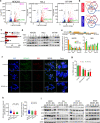
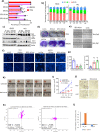
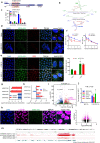

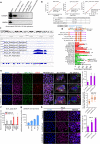
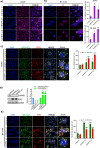
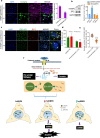
Similar articles
-
Natural antisense transcripts with coding capacity in Arabidopsis may have a regulatory role that is not linked to double-stranded RNA degradation.Genome Biol. 2005;6(6):R51. doi: 10.1186/gb-2005-6-6-r51. Epub 2005 Jun 1. Genome Biol. 2005. PMID: 15960803 Free PMC article.
-
Tombusvirus p19 Captures RNase III-Cleaved Double-Stranded RNAs Formed by Overlapping Sense and Antisense Transcripts in Escherichia coli.mBio. 2020 Jun 9;11(3):e00485-20. doi: 10.1128/mBio.00485-20. mBio. 2020. PMID: 32518184 Free PMC article.
-
The double-stranded transcriptome of Escherichia coli.Proc Natl Acad Sci U S A. 2014 Feb 25;111(8):3134-9. doi: 10.1073/pnas.1315974111. Epub 2014 Jan 22. Proc Natl Acad Sci U S A. 2014. PMID: 24453212 Free PMC article.
-
Overlapping transcripts, double-stranded RNA and antisense regulation: a genomic perspective.Cell Mol Life Sci. 2006 Sep;63(18):2102-18. doi: 10.1007/s00018-006-6070-2. Cell Mol Life Sci. 2006. PMID: 16847578 Free PMC article. Review.
-
Regulation of inducible gene expression by natural antisense transcripts.Front Biosci (Landmark Ed). 2012 Jan 1;17(3):938-58. doi: 10.2741/3965. Front Biosci (Landmark Ed). 2012. PMID: 22201782 Review.
Cited by
-
IER3: exploring its dual function as an oncogene and tumor suppressor.Cancer Gene Ther. 2025 Apr;32(4):450-463. doi: 10.1038/s41417-025-00891-y. Epub 2025 Mar 16. Cancer Gene Ther. 2025. PMID: 40090972 Free PMC article.
-
PITAR, a DNA damage-inducible cancer/testis long noncoding RNA, inactivates p53 by binding and stabilizing TRIM28 mRNA.Elife. 2024 Sep 20;12:RP88256. doi: 10.7554/eLife.88256. Elife. 2024. PMID: 39302097 Free PMC article.
-
Histone acetylation-related IncRNA: Potential biomarkers for predicting prognosis and immune response in lung adenocarcinoma, and distinguishing hot and cold tumours.Front Immunol. 2023 Mar 17;14:1139599. doi: 10.3389/fimmu.2023.1139599. eCollection 2023. Front Immunol. 2023. PMID: 37006256 Free PMC article.
-
Harderian Gland Development and Degeneration in the Fgf10-Deficient Heterozygous Mouse.J Dev Biol. 2024 Jun 3;12(2):16. doi: 10.3390/jdb12020016. J Dev Biol. 2024. PMID: 38921483 Free PMC article.
-
Single-Cell Dissection of the Serrated Pathway: Cellular Heterogeneity and Genetic Causality in Colorectal Cancer.Int J Mol Sci. 2025 Jul 25;26(15):7187. doi: 10.3390/ijms26157187. Int J Mol Sci. 2025. PMID: 40806320 Free PMC article.
References
Publication types
MeSH terms
Substances
LinkOut - more resources
Full Text Sources
Molecular Biology Databases
Research Materials
Miscellaneous

